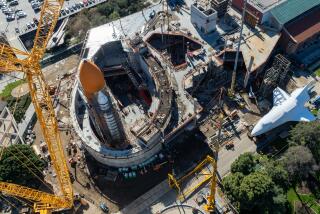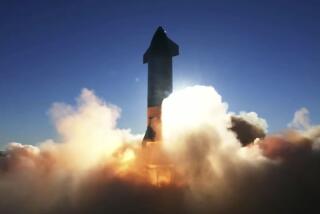Space shuttle will forgo repairs to heat-shield tiles
- Share via
NASA decided Thursday not to attempt an in-space repair of the damaged Endeavour, declaring that the shuttle’s dinged-up insulating tiles will easily survive the heat of reentry into Earth’s atmosphere.
The Mission Management Team in Houston discussed the issue for several hours before deciding that repairing the spacecraft could make things worse.
“There is a cavity in the tile; we understand that cavity,” said John Shannon, the team’s chairman. “It does not constitute a risk to the crew.”
Endeavour was hit by foam -- and possibly bits of ice -- that flaked off its external fuel tank during last week’s launch. The chunk gouged a 3-inch-wide divot in two of the heat-resistant silica tiles on the craft’s underbelly.
Damage to tiles is not uncommon. But this incident concerned NASA managers because the gouge almost reached the aluminum body of the spacecraft. Heat from the friction of reentry can reach 2,300 degrees on the underbelly of the shuttle, while aluminum begins to melt at 1,200 degrees.
After conducting engineering analyses and heat tests, NASA found that the temperatures at the base of the gash will not approach those temperatures, reaching at most 326 degrees.
Shannon said the management group of about 150 engineers was unanimous in its view that the crew would not be in danger flying the spacecraft back to Earth. The only differing opinion came from an engineering group at Johnson Space Center, which believed the danger of further damaging the shuttle during reentry was reason enough to send two astronauts out to do repairs. That group said it would be “prudent” to squirt a caulklike substance called “the goo” into the cavity.
Some experts agreed that a repair should be attempted. “If they think this is really a fix, by God they should try it,” said Stanford University physicist Doug D. Osheroff, who worked on the investigation into the 2003 Columbia accident. He said NASA’s hesitancy reveals a lack of confidence in the astronauts’ competence to make repairs.
Shannon said he wouldn’t hesitate to order the repair if there were a danger of losing the crew on the reentry, as occurred with Columbia, which was damaged much more seriously on launch. “We would have no qualms whatsoever,” Shannon said.
Shannon said extensive testing was done on a model of the tile gash. A repair would change the shape of the cavity in ways that might not be better, he said.
Also, he said, the caulking material and the applicator have never been tested in space. It could be more difficult than expected to squirt just the right amount.
The crew also reported a ding Thursday on the windshield above the commander’s seat. Engineers said they believed it was caused by a piece of space debris, or a micrometeroid. Shannon said mission managers were not worried about the divot, which penetrated about a millimeter.
Endeavour is scheduled return to Earth on Wednesday at Cape Canaveral, Fla., but the approach of Hurricane Dean could affect those plans.
NASA has several backup landing sites, including Edwards Air Force Base in California.
--
More to Read
Sign up for Essential California
The most important California stories and recommendations in your inbox every morning.
You may occasionally receive promotional content from the Los Angeles Times.













